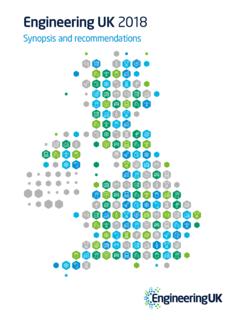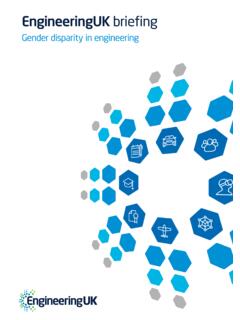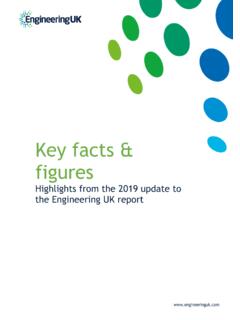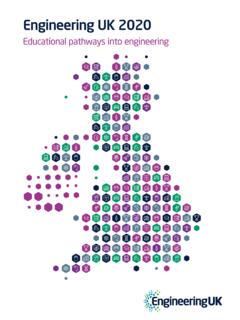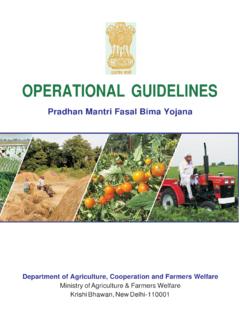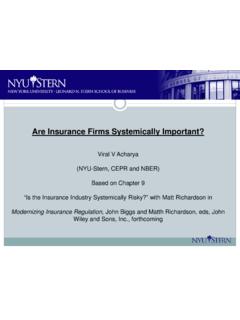Transcription of Engineering UK 2017
1 Engineering UK 2017 The state of engineeringEngineering UK 2017 AuthorsWe gratefully acknowledge contributions and support from:The authors for Engineering UK 2017 were Robin Mellors-Bourne (lead author), Director of Research & Intelligence at the Careers Research & Advisory Centre (CRAC); Tom May, Research Manager, EngineeringUK; Karen Haynes, Director Frontinus Ltd; Marianne Talbot, educational research would also like to thank the following for their valuable contributions:Ewan Greig Sales Support Project Manager, Roevin EngineeringElnaz Kashefpakdel Research Analyst, Education & Employers TaskforceRhys Morgan Director, Engineering and Education, Royal Academy of EngineeringVerity O Keefe Senior Policy Adviser, EEF the manufacturers organisationKaty Pell Campaigns Adviser, CBIJon Prichard Chief Executive Officer, Engineering CouncilTammy Simmons Marketing and Communications Manager, Engineering CouncilCharles Tracy Head of Education, Institute of PhysicsAlasdair Waddell Group Talent Acquisition Manager, Network RailAnn Watson Chief Executive, SemtaThe state of Engineering Foreword IEngineering a better UKII Foreword The state of engineeringThis annual report summarises how Engineering contributes to the UK economy, and gives an in-depth analysis of the supply and demand trends in UK Engineering talent.
2 The report is used extensively by policy-makers, educators and employers of current and future engineers. As such it is very important that the data are collated objectively, their quality assurance improved annually, and that the conclusions drawn in the Synopsis and main text are all solidly evidence-based, and not reflecting the agenda of any particular organisation. That is why the Synopsis and text that comprise this report are deliberately limited to data and fact-based modelling and conclusions, which are open to all to interpret and draw upon. The main body of the report is a public good , and EngineeringUK hopes it will be increasingly referenced and Foreword is different. It reflects the joint recommendations of the undersigned, being respectively President of the Royal Academy of Engineering and Chair of EngineeringUK. These are our personal recommendations, informed by the findings in the Report and directed at all those interested in the future of the UK, and the immense role that Engineering and technology currently plays, and needs to play in post-Brexit Britain.
3 We do not claim they reflect the consensus views of the entire Engineering sector. But we do think they shine a powerful light on the best way forward to ensure Engineering has the supply of talent to contribute to the UK in the critically important way that it report highlights that: Engineering contributes 26% of the UK s GDP viewed in terms of Gross Value Added, its contribution is more than that of the retail and wholesale and financial and insurance sectors combined Engineering activity has a particularly high wider employment multiplier effect: every extra person employed in Engineering supports another other jobsAs the global economy evolves and Britain prepares for a new future, Engineering and technology will play an ever more vital role in driving our economy, creating employment, building the essential infrastructure to compete in the modern world, and enabling a higher quality of life for all: from cleaner air in cities to faster broadband.
4 From growth of high-tech start-ups to more energy-efficient will be a tough world in which to compete: the underlying trend towards the hourglass economy predicts increasing demand for highly skilled jobs which leverage a strong STEM (Science, Technology, Engineering and Maths) skills set, and fast growth of knowledge-based services. There are some positive signs among the data in this report: 9% more Engineering and technology first degrees obtained in 2014/15 than the year before ForewordThe state of Engineering Foreword III Highest number of Engineering related apprenticeship starts in England for ten years More 11-16 year olds would consider a career in Engineering (up from 40% to 51% in four years). But there continue to be real concerns, which highlight why efforts should be redoubled to improve STEM education, to attract young people into Engineering , and to retain, motivate and improve the skills of those already in Engineering : Engineering graduate supply falls well short of demand: we conclude from the report, a shortfall of at least 20,000 annually (and likely higher, depending on assumptions) We are highly dependent on attracting and retaining international talent from the EU and beyond to help meet this shortfall: a vital part of post-Brexit policies Our postgraduate Engineering and technology degrees are successful internationally, but the proportion of UK-domiciled graduates is becoming too low to be sustainable in the long-term (down to 25% of taught Engineering and technology postgraduate qualifications, in 2014/15) Efforts to attract girls and women into Engineering are falling short.
5 Today less than 1 in 8 of the Engineering workforce is female; boys are times more likely to study A level Physics (in England, Wales and Northern Ireland) than girls; and five times more likely to gain an Engineering and technology degree. This is the backdrop to our recommendations, above all: To promote the role and contribution of Engineering and technology to the UK To improve the UK supply of engineers, and of Engineering and technology skills And in particular: 1. E ncourage many more pupils to choose STEM subjects and make well-informed choices that maintain the option of a career in Engineering and technology 2. I ncrease diversity in Engineering and technology, through the entire education system and into and throughout employment3. Draw on the talent already in the workforce: increase the skills, and improve the retention, of existing Engineering employees and attract employees from other sectors4. Enhance the vital international dimension in UK Higher Education: world-class, welcoming and open for study and subsequent employment 5.
6 Develop an industrial strategy that reinforces and sustains Engineering s contributions to the UK, and that recognises and helps to address the STEM skills gap We hope these recommendations resonate with all those who dip into this report or use it at some length. We also hope that they will influence the agendas of everyone involved in the relevant aspects of Government, education and employment, and so help to galvanise more action, for the good of the UK economy and for future Dame Ann Dowling President of the Royal Academy of EngineeringMalcolm Brinded Chairman, EngineeringUKIV Headline themes The state of engineeringRecommendations These recommendations are intended for all those organisations that have a role in the supply of future Engineering and technology talent for the UK economy, or in the employment of engineers in the UK. They reflect the need for a wide-ranging, vigorous and concerted response from a broad spectrum of organisations: government at all levels; employers; schools; further and higher education; professional Engineering organisations; and providers of education support and enrichment.
7 1. Encourage many more pupils to choose STEM subjects and make well-informed choices that maintain the option of a career in Engineering and technology Enable all young people to follow a broader curriculum up to the age of 18 Develop an inspirational and aspirational image of Engineering and communicate it through appropriate channels to young people and their influencers Increase, focus and better coordinate the engagement of employers with schools and young people to make it more systematic and effective, reducing duplication and reaching schools that are currently under-served Enhance STEM-related careers support in schools Urgently address the significant shortage of specialist teachers in physics, design and technology and computing Develop accountability measures on schools that increase participation in practical, technical and creative subjects that support Engineering skills Diversify the pathways to Engineering employment post-education, especially through further encouraging apprenticeships, including at degree level Provide UCAS-style support for vocational education2.
8 Increase diversity in Engineering and technology, through the entire education system, into and throughout employment Increase research into Engineering graduate decisions, destinations and incomes for women and ethnic minority groups Develop strategies to improve diversity and inclusion in STEM choices from school into higher, technical and vocational education Promote subject choices in ways which radically improve the diversity of those studying STEM A Level subjects Significantly increase the routes into Engineering and technology degrees for those without A level physicsThe backdrop to our recommendations are two headline themes:1. Promote the role and contribution of Engineering and technology to the UK. 2. Improve the supply of engineers, and of Engineering and technology state of Engineering Headline themes V Develop more inclusive cultures across education establishments to support the retention and successful attainment of female and other groups currently underrepresented in Engineering and technology Very significantly improve attraction of women and black and minority ethnic people into apprenticeships Develop more active and inclusive recruitment approaches, promoting Engineering to diverse candidates and focusing on future potential Develop workplace cultures that include and retain women, ethnic minority people and other underrepresented Draw on the talent already in the workforce.
9 Increase the skills, and improve the retention, of existing Engineering employees and attract employees from other sectors Understand better the flows of people between sectors and the potential to increase the numbers returning to Engineering from career breaks Resource and diversify new pathways into Engineering to retrain or up-skill those already in the workforce Encourage a more diverse range of people to consider switching to a career (at any time during their working life) in the Engineering and technology sectors4. Enhance the vital international dimension in UK Higher Education: world-class, welcoming and open for study and subsequent employment Actively promote our world-leading STEM Higher Education experience Remove international undergraduate and postgraduate students from UK net migration targets Enable more well-qualified international Engineering students to enter post-study employment in the UK5.
10 Develop an industrial strategy that reinforces and sustains the contribution of Engineering to the UK, and that recognises and helps to address the STEM skills gap Prioritise and invest to increase the STEM skills supply in quantity, quality and diversity Enable continued inward migration of skilled Engineering and technology talent to support the indigenous UK Engineering sector and global enterprises investing in the UKVI Synopsis The state of engineeringSynopsisEngineering: context and contributionsEngineering plays a vital role in the UK s economic and societal wellbeing, providing quality employment on a large scale and enabling the majority of our physical exports, as well as developing and implementing some of the key solutions to major global challenges. The UK Engineering base has a world-leading position in a range of the knowledge-intensive industrial sub-sectors responding to global challenges, as well as in the scientific and technological research and innovation that underpin by the Centre for Economics and Business Research (Cebr) suggests that the gross value added (GVA) for the UK by the Engineering sector, as defined by EngineeringUK s Footprint of Engineering jobs and companies, was 433 billion in 2015.
